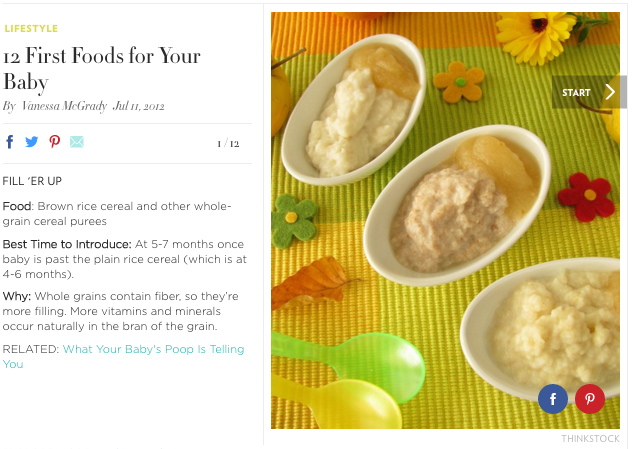She's about to take another leap toward independence, and it's going to get messy. Finger foods help your little munchkin develop new skills and explore through new tastes and textures. You'll probably be able to tell when she's ready for more when you find her reaching for the spoon at feeding time and trying to swipe food off your plate. Until she gets good at feeding herself though, get ready to take plenty of pictures of her adorable food-covered face and be prepared for lots of floor scrub-a-thons.
Safety First
Your munchkin's watching you make lunch and crawls or slides her way over to you to bribe a sample from you with one of her beautiful smiles. It's tempting to hand it over, but remember that giving your kiddo food while she's on the go increases the risk of choking. She's busy, shoves the food in, and it gets lodged at the back of her throat because she's not focused on chewing (or gumming) properly.
Melanie Potock, a certified pediatric speech language pathologist and feeding specialist in Longmont, Colorado, cautions that "choking most often has no sound because the airway is blocked. Keep a good eye on your little one!" Make sure she's safely secured into her highchair or a booster seat whenever possible. Potock says she understands that feeding time isn't always picture perfect: "While being confined to a booster or highchair isn't always possible when out and about in the community, a child should still be well-supported and seated while eating. Wherever you may be eating with your child, be sure to be face-to-face with him and pay close attention to how well your child is managing the food."
Potock recommends that parents "learn the signs of choking and how to respond. Signs include (but are not limited to) gasping for breath; turning blue; fainting; displaying a wide-eyed, open-mouth, panicky look; drooling with no sound or odd vocal sounds and gagging or vomiting in combination with the signs noted above."

RELATED: How to Empower Your Toddler
Food Choices
Now that she's figured out how to get food to her mouth, your baby can become an active participant in feeding time. However, it's probably not a good idea to hand over the spoon just yet — you may just end up with more food on her tray and in her hair than in her mouth.
However, she can now handle a variety of foods safely. "Any food that is solid enough to be picked up and then melts easily in your child's mouth is an ideal first food," Potock says. She recommends that "parents think about food as 'squish and swallow' rather than 'chew and swallow' foods at this stage."
"Safe choices include pea-sized pieces or strips of cooked fruits or vegetables, such as zucchini strips without the skin, that kids can hold in their little fists and begin to bite, or small pieces of soft, buttery pasta," Potock says.
When contemplating finger foods, size isn't the only consideration. Parents should "consider the moisture content in the food: pieces of dry, ground beef would be difficult for a child at this age. But add a flavorful sauce and be open to a little mess, and you have provided your child with a nice introduction to a new taste and texture and one that is slippery enough to 'squish and swallow,' " Potock adds.
Foods to Avoid
Even though she's safe in her highchair and focused on the task at hand, there are still some foods to avoid for her safety, such as grapes that haven't been peeled and pieces of raw carrots, celery and other hard veggies. "As a general rule, kids under the age of 2 should never have whole nuts or seeds, popcorn, whole grapes or raisins, olives or round foods like marshmallows, large "globs" of food such as nut butters or food that break into solid, hard chunks," Potock advises. "Until you are sure your little munch bug can handle larger pieces, cut grapes or other solid fruits into pea-sized pieces instead and be sure that she eats one piece at a time, even if you have to dole out the pieces one by one."
While it may seem like a monotonous task, Potock says that "many children stuff their cheeks like little chipmunks, and this can create its own choking hazard. While one raisin at a time might be fine for a toddler who chews well, a child who stuffs can easily create a giant ball of chokable raisin goop as he chews and stuffs, never remembering to swallow those first few raisins."
RELATED: Teaching Your Child to Share
Developmental Milestone
When you first start to introduce finger foods to your youngster, place them on her highchair tray and watch her rake her fingers through the food to get it into her hands. Right now, she's in the early stages of developing the fine motor skills necessary to pick up a single morsel of food with her fingers. This technique, called the pincer grasp, will develop quickly once you start giving her the opportunity to practice her skill. "The pincer grasp begins to develop between 7 and 9 months of age and is perfected by the end of the first year," Potock says. Before long, she will be able to use her thumb and forefinger to pick up food as small as a single piece of rice. Developing this pincer grasp is the first step to your little munchkin becoming a self-feeding pro.



